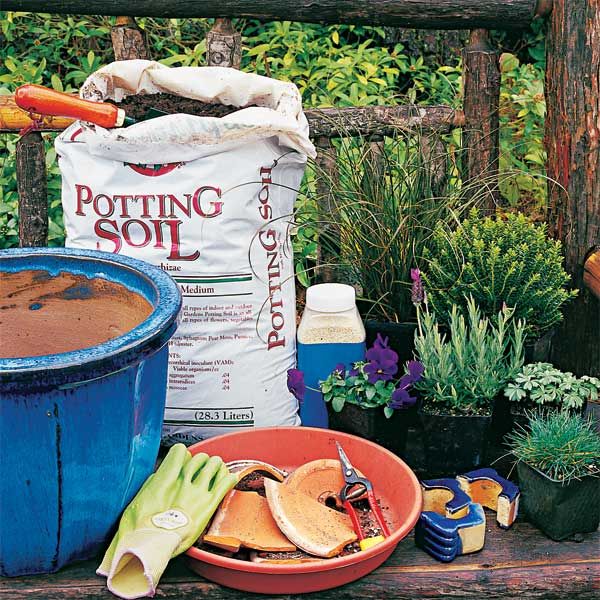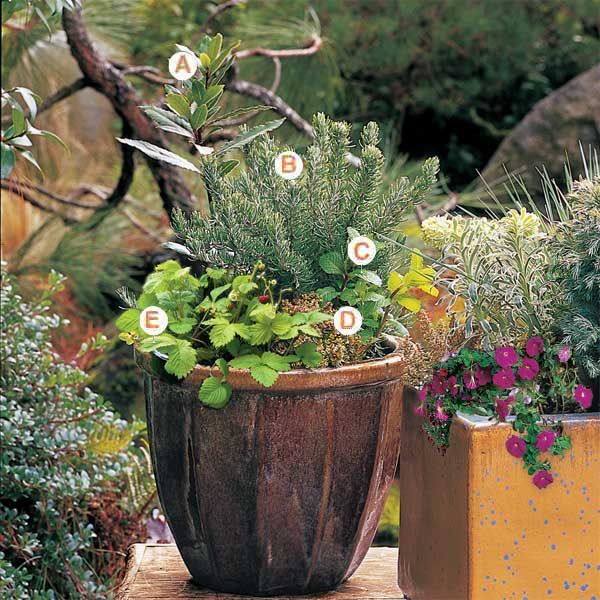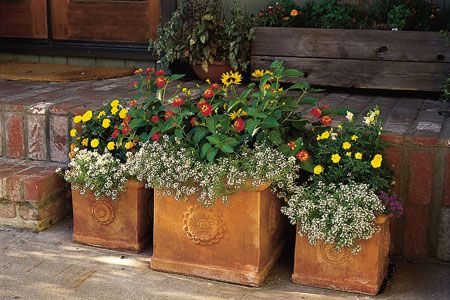Container gardening opens up a world of possibilities for plant enthusiasts, regardless of space limitations. Whether you’re brightening up a small patio, decorating a spacious deck, or adding greenery to your front porch, planting in pots allows you to create beautiful, versatile gardens in any setting. This guide will walk you through the process of selecting the right containers, preparing soil, choosing plants, and maintaining your potted garden for year-round enjoyment.
Why Choose Container Gardening?
You can even grow perennials, grasses, and dwarf evergreen shrubs in pots to provide year-round interest. Containers let you skip the major digging and weed-pulling of backyard gardening and fast-forward to the fun of designing, planting, and enjoying. You’ll get just enough dirt under your fingernails to feel like you’ve accomplished something.
Best of all, potted gardens are close-up delights. They invite you to slow down, notice the details, and savor the scents. Here’s our step-by-step guide to help you select, assemble, arrange, and grow plants in pots.
1. Pick the Right Container

Unless you’re dead-set on growing certain plant species, start with the pot—which is essentially a design element for your home—rather than the plant. A good container will help ensure the health and longevity of your potted plants. Consider size, material, and drainage when making your choice.
Selecting the Ideal Pot Size
The size of your container plays a significant role in plant health and growth. For a mixture of plants, look for containers at least 12 inches wide. Annuals typically need at least 8 inches of soil depth, while grasses and shrubs may require two or three times that amount. When in doubt, opt for a larger pot to give roots ample space to grow.
Understanding Different Pot Materials
Various container materials have pros and cons that affect both aesthetics and plant care. For example, lightweight materials may be a necessity for deck or rooftop gardens, and porous materials may be better for damp environments.
- Terra-cotta: Porous and develops a beautiful patina, but pulls water from the soil and causes it to dry out quickly
- Glazed ceramic: Retains moisture well and comes in various colors, but is heavy and may crack in freezing weather
- Metal: Can either be heavy-duty or lightweight, depending on the metal, and is highly durable, but may burn plant roots and dry out soil if kept in high heat or direct sunlight
- Composite: Usually includes plastic or fiberglass, durable and often mimics the look of more expensive materials—but less eco-friendly
- Wood: Affordable, rustic, and slow to dry out, but subject to rot and decay over time
- Natural stone: Expensive and very heavy, but may be advantageous for large plants in windy environments
Consider your garden’s style and the pot’s placement when choosing materials. For example, classical urns complement formal settings, while clean-lined geometric shapes suit modern spaces.
Ensuring Proper Drainage
Adequate drainage is essential for preventing waterlogged roots. Choose pots with drainage holes in the bottom, and cover these holes in the pot interior with pottery shards, stones, or small pieces of screening to keep soil from escaping. If placing containers on a wooden deck, use pot feet or a plant stand to elevate them and prevent water damage to the decking.
2. Select Plants that Thrive in Containers
Choosing the right plants for your containers involves considering growth habits, sunlight requirements, and aesthetic appeal.
Edible Options for Container Gardens

Grow your own herbs, vegetables, and fruits in containers for fresh, homegrown produce. Consider a miniature kitchen garden with culinary herbs like rosemary, thyme, and mint, or add dwarf fruit trees and berry plants for a productive and ornamental display.
Annuals vs. Perennials for Pots
Annuals provide quick, vibrant color and are perfect for seasonal displays. Perennials, grasses, and dwarf evergreen shrubs offer year-round interest and can be combined with annuals for dynamic container gardens.
For a long-lasting display, combine showy annuals with ornamental grasses, shrubs that change leaf color in the fall, or dwarf evergreens. Go for a mix of colors, textures, and foliage types. A tall grass, a delicate vine, and a plant with large, interesting leaves make a good combination.
“A vertical element is important to give the planting height,” says Gabrielle Whiton, a container-plant specialist at Bainbridge Gardens, a nursery on Washington’s Bainbridge Island. She often starts with a dwarf conifer, then selects lower-growing and trailing plants to go around its base.
One of those might be a flowering perennial or annual in a 4-inch container. She places this, pot and all, into the soil at the front of a large container. Once the blossoms fade, she can pull out the small pot and put in a new one with a plant just coming into bloom. She also likes to echo the pot color in her plantings.
Combining Plants: The Thriller, Filler, Spiller Method

To balance form and proportion in a pot, Ellen Zachos, owner of Acme Plant Stuff in New York City—which creates and maintains container gardens—relies on her own catchy recipe of “thrillers, fillers, and spillers.”
Thrillers are tall plants that go in the center or back, fillers are medium-size plants that fill out the middle, and spillers gracefully trail or cascade over the edge to soften the pot’s hard edges. “Resist the urge to crowd in too many different things,” says Zachos, who likes to stick to three to five types. “A lot of plants are fine, but a lot of different kinds of plants starts to look messy.”
Unless you need a deck decoration for a party next weekend, select plants that are relatively small and let them fill out. Avoid buying ones whose roots stuffing the nursery container. Dense root balls shed water, so these plants may become parched once you repot them, even if you water often. Pair up plants that are suited to the same exposure, whether sun, part sun, or shade, and that have similar water requirements.
3. Prepare Your Potting Mix
While it might be tempting to simply dig up soil from your yard or garden to fill the pot, this type of soil is typically too heavy and may introduce diseases to potted plants. Choose a pre-bagged potting soil, which has been sterilized to prevent plant disease, or create your own blend.
Creating a Balanced Soil Blend
A good homemade soil mix consists of:
- Five parts compost
- One part builder’s sand
- One part vermiculite or perlite
- One-quarter part dry organic fertilizer
This blend provides excellent drainage and nutrient retention for most container plants.
Incorporating Organic Matter and Fertilizers
When you purchase your plants, ask the nursery worker about any specific nutrition or fertilizer requirements they might have.
If you’d rather not handle compost, add slow-release fertilizer granules at planting time to provide a steady supply of nutrients throughout the growing season. However, if your potting soil already includes fertilizer, there’s no need to add any more.
4. Plant with Care
Before planting, ensure your container is clean and has adequate drainage. For tall pots with shallow-rooted plants, you can fill the bottom half with lightweight materials like broken terra-cotta pot shards or Styrofoam packing peanuts to improve drainage and reduce weight.
Gently loosen root balls before planting, especially if they’re tightly wound. Start planting from the center or with the largest specimen and work outward. Fill in around plants with potting mix, firming gently to eliminate air pockets. Aim to keep the plants at the same soil level they had in their original containers, about 1 to 2 inches below the pot’s rim.
Finally, water thoroughly after planting to settle the soil and ensure good root-to-soil contact. You may need to add a bit more soil after the first watering.
5. Set up a Schedule
A good care schedule, including watering and fertilizing, is essential for the growth and continued health of your new potted plants.
Watering Strategies for Container Gardens
Container plants typically need more frequent watering than in-ground plants, especially if they’re in porous containers or dry environments. Check soil moisture regularly and water when the top 2 to 3 inches of soil feel dry. Water deeply until you see it flowing from the drainage holes.
For outdoor pants, adjust your watering schedule against rain. Waterlogged soil can deplete nutrients from the soil and contribute to root rot, so ensure proper drainage and dump out water-catching trays frequently.
Fertilizing Schedule and Methods
Note that not all potted plants require fertilizing—for example, some herbs do best in nutrient-poor soil—but for those that do, you’ll have some choices to make.
Slow-Release vs. Water-Soluble Fertilizers
Slow-release pellets continue to add nutrients to the soil for 60 to 120 days, depending on the formula. Organic fertilizer materials like fish meal or alfalfa pellets will also release nutrients for about two months. These are excellent for long-term nutrition, but as the name suggests, they are slow-acting. You won’t see results right away.
Water-soluble fertilizers, on the other hand, are used by plants very quickly. However, they don’t stay in the soil as long, so you’ll need to fertilize more often—anywhere from two to six weeks. In particular, large or fast-growing plants may benefit from this type of fertilizer.
You can use a combination of these two types, adding slow-release pellets to the soil and supplementing with water-soluble formulas when needed, but pay attention to the manufacturer’s instructions and keep a close eye on your plants. Over-fertilizing can actually damage the plant and contribute to environmental problems from run-off.
Nutritional Content
Plant fertilizers contain nitrogen (N), phosphorus (P), and potassium (K), plus trace minerals. All-purpose fertilizers will have balanced NPK ratios, but flowering and fruiting plants tend to benefit from higher P and K levels. If you have questions, ask at the nursery or garden store.
Pruning and Maintenance Tips
Regular maintenance keeps your container garden looking its best:
- Remove spent blooms to encourage continued flowering
- Trim overgrown branches to maintain shape
- Replace or refresh plants as seasons change
6. Catch Common Problems Early
Even well-maintained container gardens can face challenges. Here’s how to address common issues with container gardens.
Dealing with Pests in Potted Plants
Inspect your plants regularly for signs of pests. Common container garden pests include aphids, spider mites, and whiteflies. Use insecticidal soap or neem oil for organic pest control, or remove pests manually for small infestations.
Addressing Soil and Drainage Problems
If water pools on the soil surface or drains too slowly, your pot may have inadequate drainage. Consider repotting with fresh, well-draining soil mix or adding more drainage holes to the container.
Reviving Struggling Container Plants
For plants showing signs of stress, assess their growing conditions. Adjust watering, light exposure, or fertilization as needed. Prune away any dead or diseased parts and consider moving the container to a more suitable location.
7. Adapt for Changing Seasons
Pay attention to temperature and climate, adjusting your maintenance routine as necessary to help keep your container plants healthy year-round.
Spring and Summer Care
As temperatures rise, increase watering frequency and monitor for pest activity. Provide shade for sun-sensitive plants during the hottest part of the day. Continue regular fertilization to support active growth.
Fall and Winter Protection
Prepare your container garden for colder months by:
- Moving tender plants indoors or to protected areas
- Grouping pots together for insulation
- Adding mulch to the soil surface for extra protection
- Reducing watering frequency as plant growth slows
To create weather-resistant planters, consider hardy evergreens or winter-blooming plants to maintain interest during colder months.
Our Conclusion
Container gardening offers endless possibilities for creating beautiful, adaptable green spaces in any setting. By choosing the right pots, soil, and plants, and providing proper care, you can enjoy a thriving potted garden year-round. Remember to experiment with different combinations and pot placements to discover what works best in your space.

